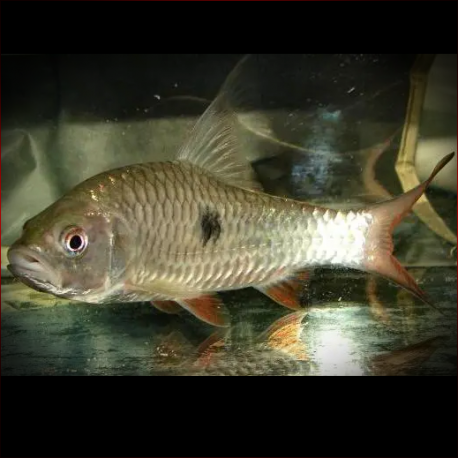More info
Datasheet
| Minimum Tank Size | 860 litres / 227.19 US gallons |
| Maximum Size | 35.0cm / 13.78inches |
| Temperature | 20°C / 68.00°F - 25°C / 77.00°F |
| Hardness | 2.02dgH / 36ppm - 20.00dgH / 357ppm |
| pH | 6.0-8.0 |
General Description
Hampala Dispar is a species of fish belonging to the Cyprinidae family, characterized by its capacious mouth and predatory feeding habits. It is known by the common name Spotted Hampala Barb and can reach a maximum size of 35.0cm. The distinguishing feature between H. macrolepidota and H. dispar lies in their color patterns, with the former displaying dark vertical bands and black marginal stripes on its caudal fins, while the latter has a single dark blotch on the body and less defined caudal fin markings.
Aquarium Setup
The optimal aquarium setup for Hampala Dispar involves mimicking a flowing river environment with a substrate of variably-sized rocks, gravel, water-worn boulders, and driftwood branches. It is essential to maintain spotless water conditions, high dissolved oxygen levels, and adequate water movement. Being intolerant to organic waste accumulation, external filters and powerheads are recommended. The fish may require a tank size of at least 860 liters and a tightly-fitting cover due to its skittish nature.
Behaviour
Hampala Dispar captures prey using suction rather than aggressive biting and is generally peaceful with tankmates it cannot swallow. However, it may outcompete slower or timid companions for food as it grows larger and more dominant. The species exhibits gregarious behavior, developing a distinct pecking order, and should be kept in groups of five or more to prevent excessive antagonism towards subdominant individuals. When feeding, the fish demonstrates voracious behavior, leading to pack-style feeding frenzies.
Feeding and Diet
In the wild, Hampala Dispar primarily feeds on crabs, shrimp, insects, and occasionally small fish. In captivity, they accept a variety of live and frozen foods, including bloodworms, prawns, earthworms, and mussels. Avoid overfeeding and refrain from offering large amounts of mammalian or avian meat, as these can lead to health issues. The fish's feeding habits make it useful for encouraging finicky or newly-introduced tankmates to eat.
Reproduction & Dimorphism
Details about the reproduction of Hampala Dispar are not recorded. Sexually mature females are likely to have a thicker body compared to males, aiding in differentiation between the genders. The species remains unrecorded in terms of its specific reproductive behaviors and dimorphic characteristics.
Habitat and Distribution
Hampala Dispar is native to the Mekong river basin in northern Laos, flowing into Cambodia, overlapping with the distribution of H. macrolepidota. The fish thrives in clear, well-oxygenated, running waters with various substrates and can adapt to different water conditions. It is known to migrate during the rainy season and can be found in human-altered water bodies due to activities like agriculture and damming.

